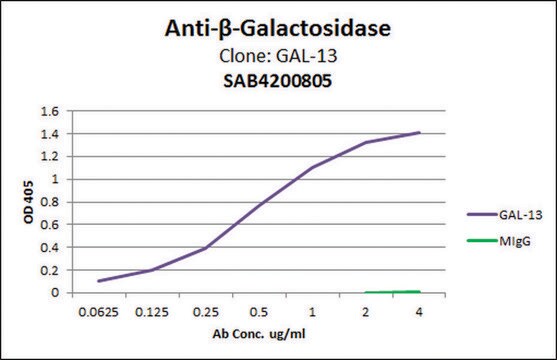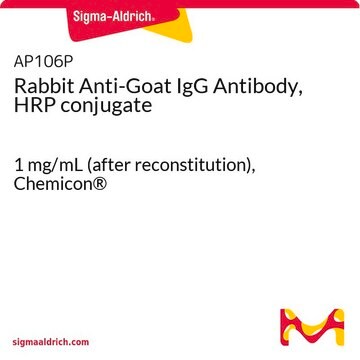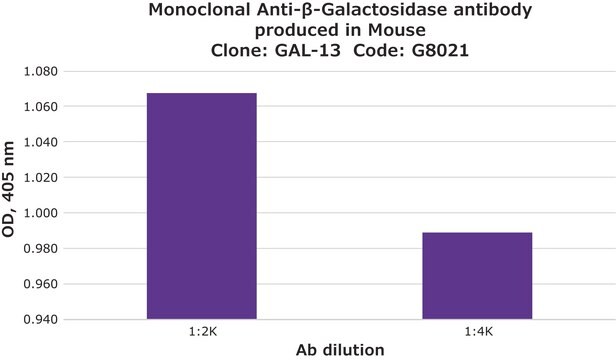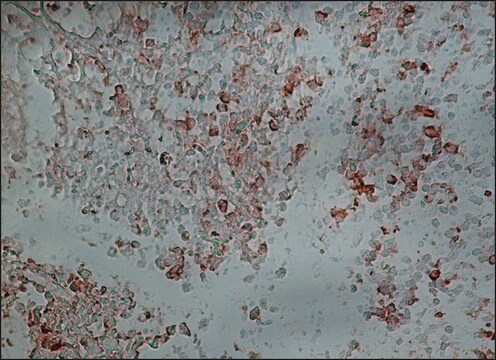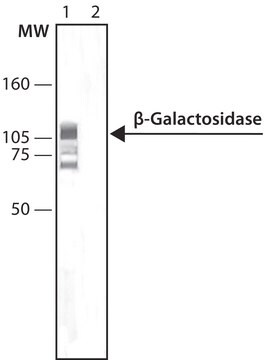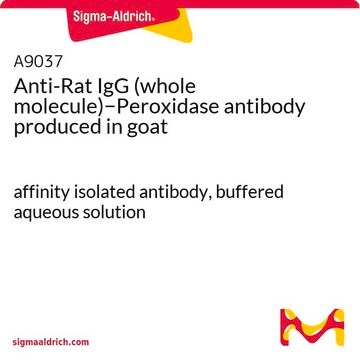推荐产品
生物源
rabbit
品質等級
抗體表格
purified immunoglobulin
抗體產品種類
primary antibodies
無性繁殖
polyclonal
物種活性
E. coli, vertebrates
製造商/商標名
Chemicon®
技術
ELISA: suitable
immunohistochemistry: suitable
immunoprecipitation (IP): suitable
western blot: suitable
NCBI登錄號
UniProt登錄號
目標翻譯後修改
unmodified
基因資訊
human ... GLB1(2720)
特異性
Recognizes Beta-Galactosidase (E. coli). Monospecific by IEP. Some cross reactivity with Beta Galactosidase from other species may occur.
免疫原
Beta-Galactosidase (E. coli).
應用
Anti-β Galactosidase Antibody is an antibody against β Galactosidase for use in ELISA, Immunohistochemistry, Immunoprecipitation, Western Blotting.
ELISA: 1:10,000-1:50,000 when assayed against 1 μg of Beta Galactosidase in a standard sandwich ELISA.
Immunoblotting: 1:2000-1:10,000 on beta-galactosidase fusion proteins.
Immunohistochemistry: 1:1,000-1:5000 on tissue fixed with 4% paraformaldehyde.
Immunoprecipitation
Optimal working dilutions must be determined by end user.
Immunoblotting: 1:2000-1:10,000 on beta-galactosidase fusion proteins.
Immunohistochemistry: 1:1,000-1:5000 on tissue fixed with 4% paraformaldehyde.
Immunoprecipitation
Optimal working dilutions must be determined by end user.
Research Category
Epitope Tags & General Use
Epitope Tags & General Use
Research Sub Category
Epitope Tags
Epitope Tags
外觀
Ammonium sulfate precipitation and DEAE-cellulose chromatography
Format: Purified
Immunoglobulin Purified by delipidation, salt fractionation and ion-exchange chromatography. Liquid in 0.02M Potassium Phosphate buffer, 0.15M Sodium Chloride, with 0.01% sodium azide.
儲存和穩定性
Maintain for 2 years at -20°C from date of shipment. Aliquot to avoid repeated freezing and thawing. For maximum recovery of product, centrifuge the original vial after thawing and prior to removing the cap.
分析報告
Control
Proteins tagged with beta galactosidase
Proteins tagged with beta galactosidase
其他說明
Concentration: Please refer to the Certificate of Analysis for the lot-specific concentration.
法律資訊
CHEMICON is a registered trademark of Merck KGaA, Darmstadt, Germany
免責聲明
Unless otherwise stated in our catalog or other company documentation accompanying the product(s), our products are intended for research use only and are not to be used for any other purpose, which includes but is not limited to, unauthorized commercial uses, in vitro diagnostic uses, ex vivo or in vivo therapeutic uses or any type of consumption or application to humans or animals.
未找到合适的产品?
试试我们的产品选型工具.
儲存類別代碼
12 - Non Combustible Liquids
水污染物質分類(WGK)
WGK 2
Wen-Hsin Hsu et al.
Scientific reports, 7(1), 12386-12386 (2017-09-30)
Chicken Ovalbumin Upstream Promoter-Transcription Factor II (COUP-TFII) plays pivotal roles in cell growth, cell differentiation, and cell fate determination. Although genome-wide studies have identified COUP-TFII binding on gene sets mainly involved in neural crest cell (NCC) development and craniofacial morphogenesis
Aki Takahashi et al.
The Journal of neuroscience : the official journal of the Society for Neuroscience, 35(16), 6452-6463 (2015-04-24)
Although the dorsal raphe nucleus (DRN) has long been linked to neural control of aggression, little is known about the regulatory influences of the DRN when an animal engages in either adaptive species-typical aggressive behavior or escalated aggression. Therefore it
Anna Benedykcinska et al.
Disease models & mechanisms, 9(2), 211-220 (2015-12-26)
Targeted cell- or region-specific gene recombination is widely used in the functional analysis of genes implicated in development and disease. In the brain, targeted gene recombination has become a mainstream approach to study neurodegeneration or tumorigenesis. The use of the
Timothy J Cherry et al.
The Journal of neuroscience : the official journal of the Society for Neuroscience, 31(20), 7365-7379 (2011-05-20)
Members of the basic helix-loop-helix (bHLH) family of transcription factors have been shown to control critical aspects of development in many tissues. To identify bHLH genes that might regulate specific aspects of retinal cell development, we investigated the expression of
Bei-Yu Chen et al.
Journal of neuroscience research, 91(1), 30-41 (2012-10-02)
Brain-derived neurotrophic factor (BDNF) has critical functions in promoting survival, expansion, and differentiation of neural stem cells (NSCs), but its downstream regulation mechanism is still not fully understood. The role of BDNF in proliferation and differentiation of NSCs through Wnt/β-catenin
我们的科学家团队拥有各种研究领域经验,包括生命科学、材料科学、化学合成、色谱、分析及许多其他领域.
联系技术服务部门